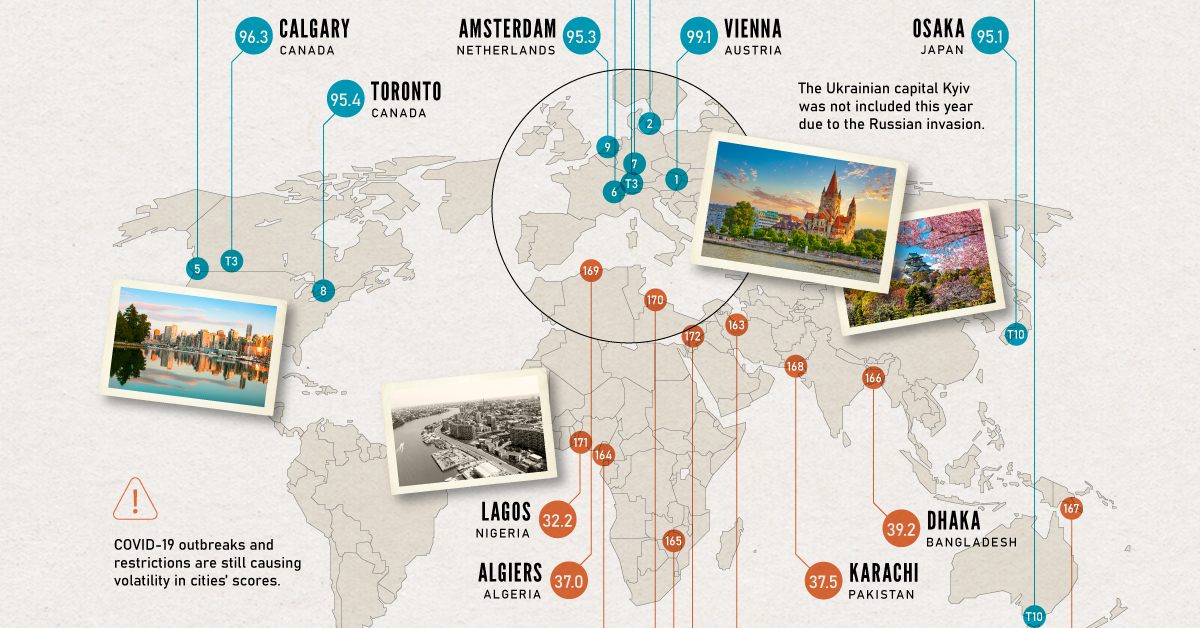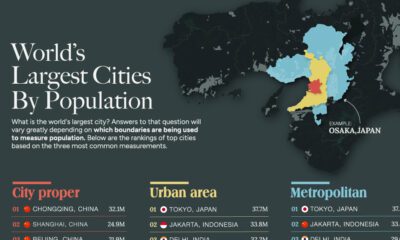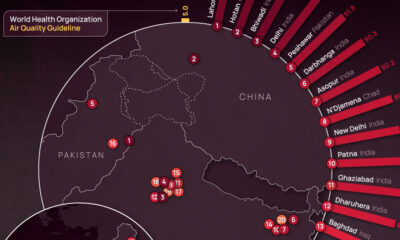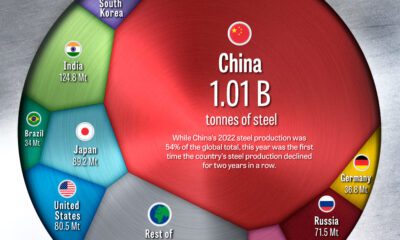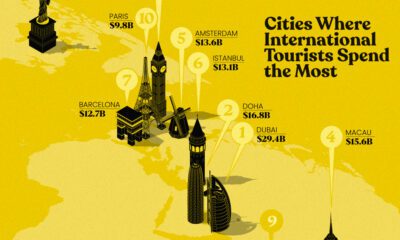Demographics
Ranked: The Most and Least Livable Cities in 2022
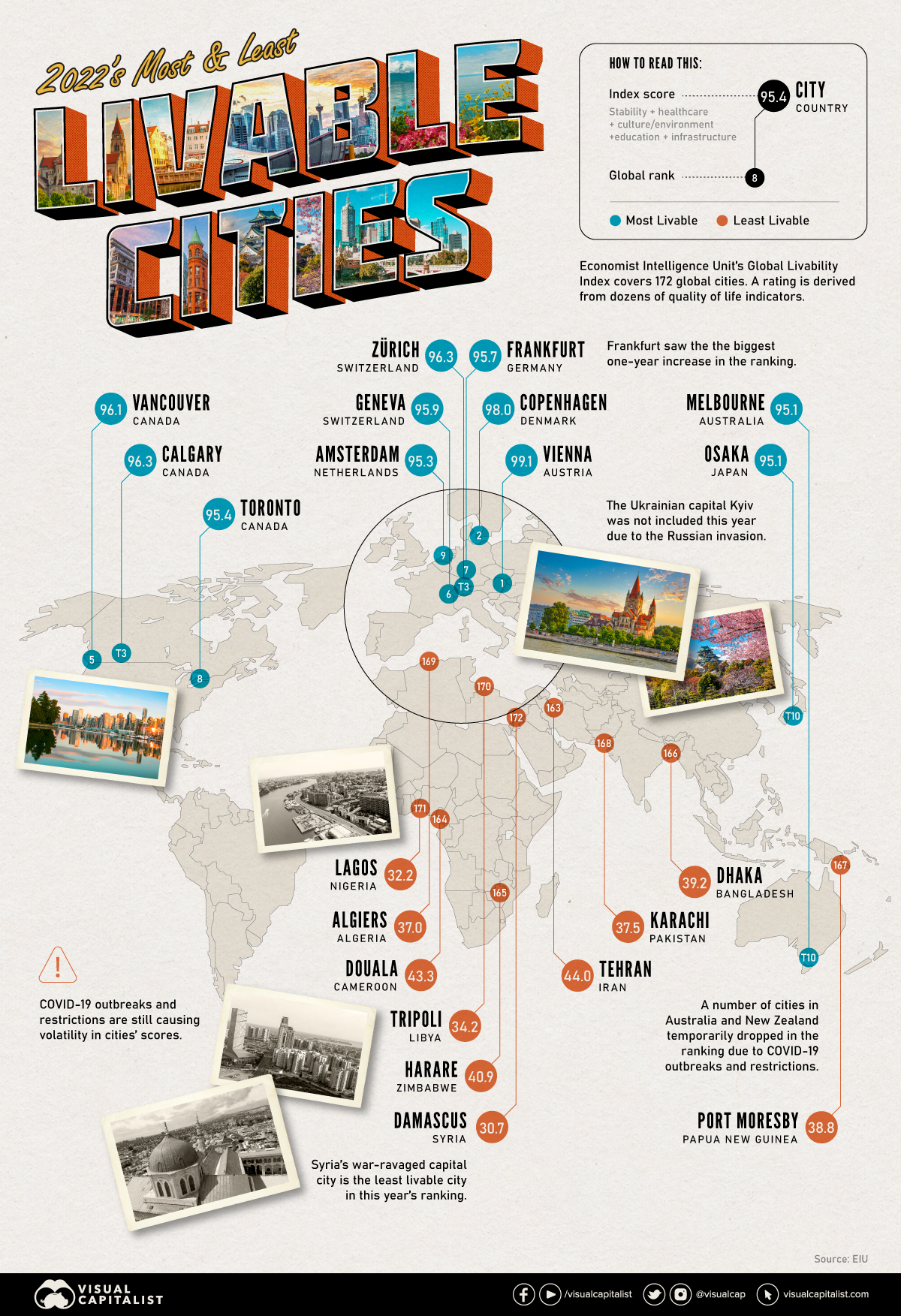
Ranked: The Most and Least Livable Cities in 2022
Pandemic restrictions changed the livability of many urban centers worldwide as cultural sites were shuttered, restaurant dining was restricted, and local economies faced the consequences. But as cities worldwide return to the status quo, many of these urban centers have become desirable places to live yet again.
This map uses annual rankings from the Economist Intelligence Unit (EIU) to show the world’s most livable cities, measuring different categories including: stability, healthcare, culture and environment, education, and infrastructure.
A Quick Note on Methodology
The ranking attempts to assess which cities across the globe provide the best living conditions, by assigning a score on 30 quantitative and qualitative measures across the five categories with the following weightings:
- Healthcare (20%)
- Culture & Environment (25%)
- Stability (25%)
- Education (10%)
- Infrastructure (20%)
Of the 30 factors within these categories, the qualitative ones are assigned as acceptable, tolerable, uncomfortable, undesirable, or intolerable by a team of expert analysts. Quantitative measures are given a score based on a number of external data points. Everything is then weighted to provide a score between 1-100, with 100 being the ideal.
Ranked: The 10 Most Livable Cities
Of the 172 cities included in the rankings, many of the most livable cities can be found in Europe. However, three of the top 10 are located in Canada: Vancouver, Calgary, and Toronto.
Vienna has been ranked number one many times, most recently in 2019. According to the EIU, the Austrian capital only fell out of the top slot during the pandemic years because its famous museums and restaurants were shuttered.
| Rank | City | Country | Score |
|---|---|---|---|
| #1 | Vienna | 🇦🇹 Austria | 99.1 |
| #2 | Copenhagen | 🇩🇰 Denmark | 98.0 |
| #3 | Zurich | 🇨🇭 Switzerland | 96.3 |
| #3 | Calgary | 🇨🇦 Canada | 96.3 |
| #5 | Vancouver | 🇨🇦 Canada | 96.1 |
| #6 | Geneva | 🇨🇭 Switzerland | 95.9 |
| #7 | Frankfurt | 🇩🇪 Germany | 95.7 |
| #8 | Toronto | 🇨🇦 Canada | 95.4 |
| #9 | Amsterdam | 🇳🇱 Netherlands | 95.3 |
| #10 | Osaka | 🇯🇵 Japan | 95.1 |
| #10 | Melbourne | 🇦🇺 Australia | 95.1 |
Only one Asian city, Osaka, makes the top 10 list, tying with Melbourne for 10th place. Notably, not a single U.S. city is found in the top ranks.
Editor’s note: Two cities tie for both the #3 and #10 ranks, meaning that the “top 10” list actually includes 12 cities.
Ranked: The 10 Least Livable Cities
Some of the least livable cities in the world are located across Africa and Central Asia.
| Rank | City | Country | Score |
|---|---|---|---|
| #163 | Tehran | 🇮🇷 Iran | 44.0 |
| #164 | Douala | 🇨🇲 Cameroon | 43.3 |
| #165 | Harare | 🇿🇼 Zimbabwe | 40.9 |
| #166 | Dhaka | 🇧🇩 Bangladesh | 39.2 |
| #167 | Port Moresby | 🇵🇬 Papua New Guinea | 38.8 |
| #168 | Karachi | 🇵🇰 Pakistan | 37.5 |
| #169 | Algiers | 🇩🇿 Algeria | 37.0 |
| #170 | Tripoli | 🇱🇾 Libya | 34.2 |
| #171 | Lagos | 🇳🇬 Nigeria | 32.2 |
| #172 | Damascus | 🇸🇾 Syria | 30.7 |
Many of the least livable cities are within conflict zones, contributing to the low ratings. However, these regions are also home to some of the world’s fastest growing cities, presenting many opportunities for ambitious residents.
The Biggest Changes in Ranking
Let’s take a look at the cities that moved up the global rankings most dramatically compared to last year’s data.
Moving Up: The 10 Most Improved Cities
| City | Country | Overall Rank | Rank Change |
|---|---|---|---|
| Frankfurt | 🇩🇪 Germany | #7 | +32 |
| Hamburg | 🇩🇪 Germany | #16 | +31 |
| Dusseldorf | 🇩🇪 Germany | #22 | +28 |
| London | 🇬🇧 UK | #33 | +27 |
| Manchester | 🇬🇧 UK | #28 | +26 |
| Paris | 🇫🇷 France | #19 | +23 |
| Brussels | 🇧🇪 Belgium | #24 | +22 |
| Amsterdam | 🇳🇱 Netherlands | #9 | +21 |
| Athens | 🇬🇷 Greece | #73 | +19 |
| Los Angeles | 🇺🇸 US | #37 | +18 |
Here’s a look at the cities that fell the most in the rankings since last year’s report.
Moving Down: The 10 Cities That Tumbled
| City | Country | Overall Rank | Rank Change |
|---|---|---|---|
| Wellington | 🇳🇿 New Zealand | #50 | -46 |
| Auckland | 🇳🇿 New Zealand | #34 | -33 |
| Adelaide | 🇦🇺 Australia | #30 | -27 |
| Perth | 🇦🇺 Australia | #32 | -26 |
| Houston | 🇺🇸 US | #56 | -25 |
| Reykjavik | 🇮🇸 Iceland | #48 | -25 |
| Madrid | 🇪🇸 Spain | #43 | -24 |
| Taipei | 🇹🇼 Taiwan | #53 | -20 |
| Barcelona | 🇪🇸 Spain | #35 | -19 |
| Brisbane | 🇦🇺 Australia | #27 | -17 |
According to the report, a number of cities in New Zealand and Australia temporarily dropped in the ranking due to COVID-19 restrictions.
It’s also worth noting that some Eastern European cities moved down in the rankings because of their close proximity to the war in Ukraine. Finally, Kyiv was not included in this year’s report because of the conflict.
Urbanization and Livability
As of 2021, around 57% of the world’s population lives in urban centers and projections show that people worldwide will continue to move into cities.
While there are more amenities in urban areas, the pandemic revealed many issues with urbanization and the concentration of large populations. The stress on healthcare systems is felt most intensely in cities and restrictions on public outings are some of the first measures to be introduced in the face of a global health crisis.
Now with the cost of living rising, cities may face pressures on their quality of life, and governments may be forced to cut spending on public services. Regardless, people worldwide continue to see the benefits of city living—it’s projected that over two-thirds of the global population will live in cities by 2050.
Demographics
The Smallest Gender Wage Gaps in OECD Countries
Which OECD countries have the smallest gender wage gaps? We look at the 10 countries with gaps lower than the average.
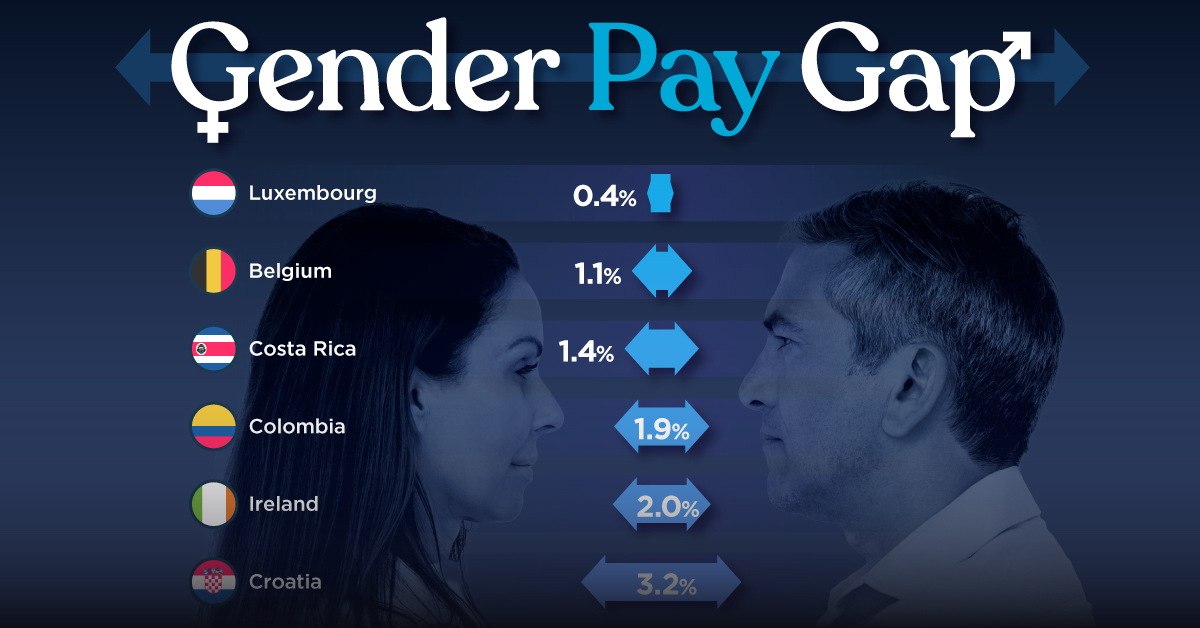
The Smallest Gender Pay Gaps in OECD Countries
This was originally posted on our Voronoi app. Download the app for free on iOS or Android and discover incredible data-driven charts from a variety of trusted sources.
Among the 38 member countries in the Organization for Economic Cooperation and Development (OECD), several have made significant strides in addressing income inequality between men and women.
In this graphic we’ve ranked the OECD countries with the 10 smallest gender pay gaps, using the latest data from the OECD for 2022.
The gender pay gap is calculated as the difference between median full-time earnings for men and women divided by the median full-time earnings of men.
Which Countries Have the Smallest Gender Pay Gaps?
Luxembourg’s gender pay gap is the lowest among OECD members at only 0.4%—well below the OECD average of 11.6%.
| Rank | Country | Percentage Difference in Men's & Women's Full-time Earnings |
|---|---|---|
| 1 | 🇱🇺 Luxembourg | 0.4% |
| 2 | 🇧🇪 Belgium | 1.1% |
| 3 | 🇨🇷 Costa Rica | 1.4% |
| 4 | 🇨🇴 Colombia | 1.9% |
| 5 | 🇮🇪 Ireland | 2.0% |
| 6 | 🇭🇷 Croatia | 3.2% |
| 7 | 🇮🇹 Italy | 3.3% |
| 8 | 🇳🇴 Norway | 4.5% |
| 9 | 🇩🇰 Denmark | 5.8% |
| 10 | 🇵🇹 Portugal | 6.1% |
| OECD Average | 11.6% |
Notably, eight of the top 10 countries with the smallest gender pay gaps are located in Europe, as labor equality laws designed to target gender differences have begun to pay off.
The two other countries that made the list were Costa Rica (1.4%) and Colombia (1.9%), which came in third and fourth place, respectively.
How Did Luxembourg (Nearly) Eliminate its Gender Wage Gap?
Luxembourg’s virtually-non-existent gender wage gap in 2020 can be traced back to its diligent efforts to prioritize equal pay. Since 2016, firms that have not complied with the Labor Code’s equal pay laws have been subjected to penalizing fines ranging from €251 to €25,000.
Higher female education rates also contribute to the diminishing pay gap, with Luxembourg tied for first in the educational attainment rankings of the World Economic Forum’s Global Gender Gap Index Report for 2023.
See More Graphics about Demographics and Money
While these 10 countries are well below the OECD’s average gender pay gap of 11.6%, many OECD member countries including the U.S. are significantly above the average. To see the full list of the top 10 OECD countries with the largest gender pay gaps, check out this visualization.
-

 Mining2 weeks ago
Mining2 weeks agoCharted: The Value Gap Between the Gold Price and Gold Miners
-

 Real Estate1 week ago
Real Estate1 week agoRanked: The Most Valuable Housing Markets in America
-

 Business1 week ago
Business1 week agoCharted: Big Four Market Share by S&P 500 Audits
-

 AI1 week ago
AI1 week agoThe Stock Performance of U.S. Chipmakers So Far in 2024
-

 Misc1 week ago
Misc1 week agoAlmost Every EV Stock is Down After Q1 2024
-

 Money2 weeks ago
Money2 weeks agoWhere Does One U.S. Tax Dollar Go?
-

 Green2 weeks ago
Green2 weeks agoRanked: Top Countries by Total Forest Loss Since 2001
-

 Real Estate2 weeks ago
Real Estate2 weeks agoVisualizing America’s Shortage of Affordable Homes

